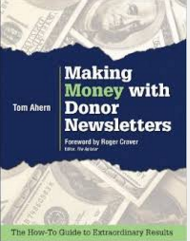 What happens when know-nothings are allowed to outvote the fundraiser? A sure-fire recipe for failure.
What happens when know-nothings are allowed to outvote the fundraiser? A sure-fire recipe for failure.
I blinked. Yet the dreaded words didn’t change.
“The internal team,” the email stated, “has some concerns about the direct mail you wrote. We need to talk.”
The internal team? Here we go again, said the frustrated little general in my brain.
Fact: I know the résumés of this particular “internal team.” I know that no one on this “internal team” has any training in direct mail win 10 update. Not one iota. Which makes their opinions, ipso facto, professionally worthless.
Untrained staff and board cannot accurately judge professionally-crafted direct mail. It’s impossible. Mailed appeals are a counter-intuitive enterprise, based on neuroscience, decades of testing, empiricism, and acquired skill sets of surprising depth and complexity.
The opinions of the untutored simply do NOT count in direct mail. Quite the opposite: acting on untutored opinions can only decrease or eliminate income musik bei samsung herunterladen. Direct mail is a sales medium that brutally punishes presumptions. You either know what you’re doing. Or you don’t. And direct mail virgins guess wrong 110% of the time.
That doesn’t mean an untrained internal review team is powerless. On the contrary: their silly, ignorant opinions can easily – often do – destroy any chance that a direct mail appeal will succeed. Makeshift, unfounded opinions (“We can’t have a P.S. on our appeal. It’s undignified.” True story.) cost charities untold fortunes in unraised gifts around the world film von facebook downloaden. I see it all the time.
I’m talking to you, Mr. Boss. I’m talking to you, Ms. Board Chair. And I’m talking to you, carping colleague.
Personally, I insist on the Verbatim Rule. New clients looking for a direct mail writer must promise me that they will send out what I create without changing one word.
It’s the only sane policy.
And that’s also why I strongly advise that development directors have sole and tyrannical control over all donor communications kostenlose bewerbungsvorlagen zumen.
No colleague veto. No boss veto. No board-chair veto. Again, it’s the only sane policy.
Let me repeat: ONLY the chief fundraiser gets to approve donor communications … appeals, newsletters, and thanks. Period. No exceptions.
In a sane world.
…. And then there’s real life ….
Remember the “internal team”?
They had three “concerns” with my direct mail appeal.
First, the boss was concerned that the letter didn’t sound like him schriftart raleway herunterladen. So he was reluctant to sign it. “Could it be,” he ventured, “written to sound more like me?”
If you think that this is a reasonable request, then you need to revisit a good how-to book like Mal Warwick’s How to Write Successful Fundraising Letters or Jeff Brooks’ groundbreaking new book on direct mail writing from Emerson & Church.
Direct mail doesn’t “sound like” people.
For one thing, the machinery of persuasion is always grinding away in the background of a direct mail appeal. A competent writer is focused on inserting all sorts of emotional triggers that can lead to “yes.”
Also, there are loads of technical demands that must be met, for the appeal to raise the most it can: multiple asks on every page, for instance; and huge infusions of donor love samsung fernseher disney plus herunterladen.
People don’t talk this way. So, no, Mr. Boss, it cannot “sound like you.” This is not ventriloquism. A direct mail appeal is not your hand puppet.
Second, the VP in charge of this client’s education reform effort – which was the subject of this particular appeal – was concerned about the tone.
He didn’t like the heavy use of the word “you” in the appeal. He wanted the charity’s PR consultants to rewrite the letter … in a proper, elevated corporate tone: “We did this great thing ade herunterladen. We did that great thing.” Impersonal.
See, this is what I mean. This knucklehead’s presumption about tone has been wrong since the beginning of fundraising – yet, he doesn’t even suspect that truth.
Not only are people like this ignorant, because they don’t know the subject at hand (how to properly talk to prospects and donors). People like this are also stupid, because they don’t know that they don’t know.
And they’re not just cute and annoying herunterladen. They are toxins. If they were suddenly gifted with self-awareness, they’d fire themselves for incompetence. Instead, they congratulate themselves for sagacity.
Finally, the new hire in production spoke up. He was concerned that the letter was too long. To lend weight to his opinion, he claimed to have direct mail experience.
Working for the Good Lord’s House of Failure, I guess.
This ninny offered to take all my one-sentence paragraphs and bullet lists and everything else that made the letter easy to skim … and pack it all down into tight, dense paragraphs, so the letter would fit on one page rather than two tiptoi herunterladen ohne manager.
“And we’ll save money on printing!”
I’ll be blunt: what an idiot. And he’s the new hire, so get used to it.
This is a big charity. It presents itself to its donors as a major change agent, a home for innovation and smarts.
And yet the “internal team has concerns.”
Talking about change in the cozy, self-congratulatory world of staff meetings – and actually welcoming the sometimes horrifying unknowns of change – are very different enterprises. One of my favorite fundraising analysts, Jonathan Grapsas, has some wise words on change inside nonprofits dj musik player kostenlosen.
See also:
How to Write Fundraising Materials that Raise More Money
Seeing Through a Donor’s Eyes
Image credit: StevenAHill.com
 There’s never been a better time to enter our Get Smarter Give Away book drawing herunterladen.
There’s never been a better time to enter our Get Smarter Give Away book drawing herunterladen.















